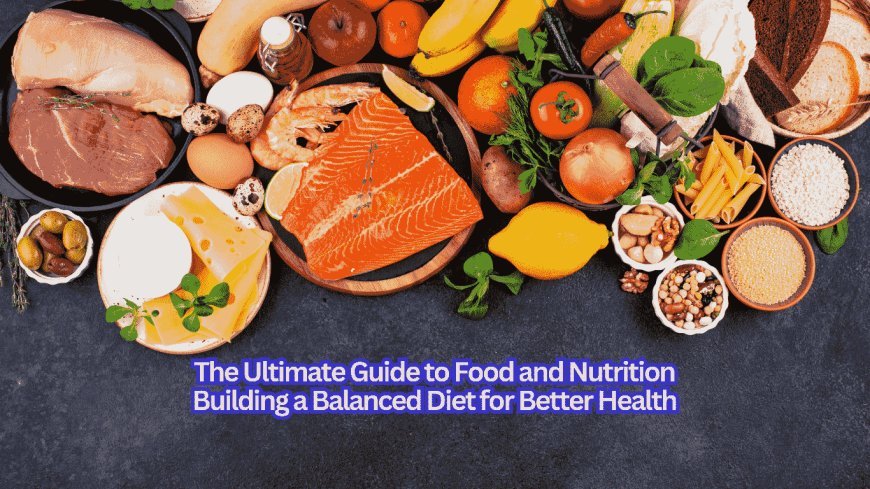The Ultimate Guide to Food and Nutrition: Building a Balanced Diet for Better Health
Learn how to create a balanced diet for better health with our ultimate guide to food and nutrition. Discover essential nutrients, healthy eating tips, and practical meal ideas

Excerpt Introduction:
Looking to eat healthily but overwhelmed by contradicting advice? This book simplifies food and nutrition basics so you can eat a balanced, healthy diet. We have everything you need to make healthier eating choices today, from macronutrients to superfoods.
The Ultimate Guide to Food and Nutrition: Building a Balanced Diet for Better Health
We often forget that food is more than fuel—it's the cornerstone of our health—in the hurry and bustle of everyday life. A balanced diet gives your body the nutrition it needs to perform efficiently, enhancing energy, mental clarity, and long-term health.
But where to begin? Building a balanced diet might be difficult with so much information. This guide simplifies what your body needs and how to feed it.
What Is a Balanced Diet?
A balanced diet gives your body the proper macronutrients (carbohydrates, proteins, and fats) and micronutrients (vitamins and minerals) to operate well. Consider it providing your body the "building blocks" it needs to develop, mend, and maintain itself.
Basics of a balanced diet:
-
Carbs: Fuel us (45–65% of our daily consumption).
-
Ten to thirty-five percent of your diet includes protein.
-
Healthy fats: Promote cell function and energy storage (20–35%).
-
Minerals and vitamins regulate physiological functions and immunity.
-
Fiber: Promotes normal digestion.
-
Water: Hydrates and regulates metabolism.
A balanced diet emphasizes variety, moderation, and nutrition. Explore each aspect to learn how to include it in your recipes.
Macronutrients: The Building Blocks of Nutrition
1. Your Body Runs on Carbohydrates
Despite their negative image, carbs are vital for brain and muscular energy.
-
Whole grains (brown rice, quinoa, and oats), fruits, vegetables, and legumes contribute to health.
-
Limit white bread, sugary snacks, and drinks.
-
Complex carbs like sweet potatoes and whole-grain pasta provide long-lasting energy.
2. Proteins: The Body’s Repair Crew
Muscle repair, immunity, and hormone synthesis need proteins.
-
Lean meats, chicken, fish, eggs, tofu, beans, lentils, and nuts are healthy.
-
Daily Need: 0.8 grams per kilogram (higher for active people).
-
Pro Tip: Mix plant- and animal-based proteins for amino acid diversity.
3. Fats: Don’t Fear the Fat
Fats cushion organs, absorb vitamins, and offer energy. Focus on healthy fats.
-
Nuts, seeds, olive oil, avocados, and salmon are healthy.
-
No-eat foods: Fried or processed meals include trans and saturated fats.
-
Tip: Cook using avocado or olive oil instead of butter.
Micronutrients: The Unsung Heroes of Nutrition
1. Vitamins
Immune function and bone health need vitamins.
-
Key Vitamins:
-
Vitamin C (oranges, strawberries, bell peppers).
-
Fortified meals, sunshine, and fatty fish provide vitamin D.
-
B vitamins (eggs, whole grains, leafy greens).
-
Pro Tip: Eat a rainbow of fruits and veggies for vitamin diversity.
2. Minerals
Calcium, potassium, and magnesium are essential for muscle, bone, and hydration.
Key Sources:
-
Calcium: Kale, dairy, fortified plant milk.
-
Iron: spinach, red meat.
-
Potassium: avocados, bananas, sweet potatoes.
The Role of Fiber and Hydration
Fiber: Keep Things Moving
Fiber improves digestion, regulates blood sugar, and prolongs fullness.
-
Fiber-rich foods: oats, whole grains, apples, broccoli, beans, flaxseeds.
-
Expert advice: Consume 25-30 grams of fiber everyday.
Water: The Overlooked Nutrient
Water is necessary for every biological function, from detoxification to temperature regulation.
-
Daily Goal: 8-10 cups (more if active).
-
Try freshening your water with lemon or cucumber slices.
Creating a Balanced Meal
After understanding the components of a balanced diet, here's how to put it together:
The Plate Method:
-
Your plate: 50% vegetables and fruits.
-
Lean protein: 25% of dish.
-
25% of the plate: whole grains/healthy carbohydrates.
-
A little avocado or nuts is healthy.
Meal Ideas:
-
Breakfast: Greek yogurt, berries, granola, chia.
-
Grilled chicken salad with mixed greens, quinoa, and olive oil dressing for lunch.
-
Baked fish, roasted sweet potatoes, and steamed broccoli for dinner.
-
Almonds, vegetarian hummus, or cooked eggs.
Foods to Limit in a Balanced Diet
All foods are allowed; however, moderation is key:
-
Salt, sugar, and harmful fats in processed foods.
-
Sugary beverages: Choose water, herbal tea, or unsweetened beverages.
-
When feasible, bake or grill instead of fry.
Superfoods to Add to Your Diet
Superfoods are nutrient-dense and beneficial in small amounts. Some to try.
-
Omega-3, fiber, and antioxidant-rich chia seeds.
-
Iron, calcium, and vitamin powerhouse spinach.
-
Antioxidant-rich blueberries are brain healthy.
-
Salmon is rich in heart-healthy omega-3s.
Common Diet Myths Debated
-
Only excessive processed carbohydrates cause weight gain. Foods like whole grains and vegetables are vital.
-
Skip meals to lose weight, but it might decrease your metabolism and cause more eating.
-
Fat-Free Is Healthier": Fat-free goods often include sugar and artificial ingredients.
Tips for Long-Term Success
-
Prep meals for the week to prevent unhealthy options.
-
Be mindful when eating: chew gently and avoid distractions.
-
Follow Your Body: Eat when you're hungry and quit when you're full.
Conclusion: Nourish Your Way to Better Health
Balanced eating isn't hard or restricting. You can maintain good eating by consuming nutrient-dense meals, keeping hydrated, and listening to your body.
Remember, little adjustments yield enormous outcomes. Start by implementing one or two ideas from this guide and progressively improve your health and happiness. Your first step toward a balanced diet? Share in the comments!

 shofiul
shofiul 





